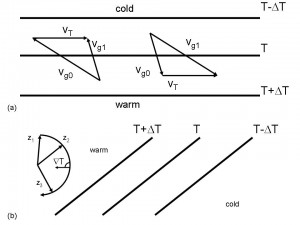Thermal wind, advection, and primitive equations
So far we just looked at the horizontal motions. However, the motion transports air-mass properties like temperature, cloud and precipitation hydrometeors or pollutants. In this unit, we will combined the approximation of the geostrophic wind, hydrostatic equation and equation of state to discriminate between warm and cold air advection and to introduce and explain the jet streams. We also take first steps to derive concepts needed/applied in meteorological models.

Learning goals
After successful completion of this unit students are able to
- interpret weather maps by applying the thermal wind concept
- apply the concepts of a barotopic or barocline atmosphere to identify cold and warm air advection and discuss fronts
- utilize the continuity equation to discuss atmospheric process
- distinguish between compressible and incompressible flow
- apply Reynolds averaging to the primitive equations
- explain the Bousinessq approximation and the inelastic approach
- explain the closure problem of turbulence and distinguish between 1st and 2nd order closure (graduate students)
Students’ Tasks
- Watch this video
- All students: Read chapter 6.4.6 to 6.6 (included) and 6.8 to 6.8.4 (included) of Lectures in Meteorology
- Graduate students: Read also chapter 6.8.4.1 to 6.8.6.1 (included)
- Participate in the discussion channel of this unit on the discussion board
- Answer the questionnaire by Thursday 2359 AKST
- Solve the problems assigned at your class level in this unit20 task sheet and submit your scanned solutions to cmoelders@alaska.edu by Thursday 2359 AKST
Supplemental material
You can find the powerpoint presentation here.
© 2019 Nicole Mölders | All rights reserved

